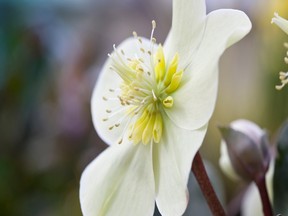
Reviews and recommendations are unbiased and products are independently selected. Postmedia may earn an affiliate commission from purchases made through links on this page.
Article content
For gardeners and non-gardeners alike, winter is at its dreariest in February, and spring colour feels like it’s still months away.
Advertisement 2
Article content
But as the gardening expert and TV host Frankie Flowers points out, just because it’s dismal outside doesn’t mean spring colour can’t be enjoyed indoors. Flowers, who will be giving a talk at the National Home Show in March, says there are plenty of ways to exercise a green thumb, and brighten up the last dark days of winter with a minimum of effort.
Article content

The most reliable way to add indoor plant colour, he says, is with flowering houseplants. Probably the easiest, and without question the most elegant, are orchids. Available in a rainbow of colours, shapes and types, orchids require only a modest amount of water and light, bloom for an extended period, and with only minimal care during their dormancy, which lasts a few months, can be induced to bloom again the next year.
Advertisement 3
Article content
Anthurium is another easy-care flowering plant, with glossy green leaves and big, red heart-shaped bracts. It thrives in humidity and does very well in a bright, warm place out of direct sunlight, such as a bathroom windowsill. On the other end of the humidity spectrum, kalanchoe is semi-succulent, meaning it actually prefers drier conditions – making it a great choice for those who tend to forget to water their plants.

Outside the window this time of year, the pleasures of the winter garden may be more subtle than during the height of summer but no less lovely. Evergreens provide structure and rich colour; some have berries in winter, and all provide shelter for small birds. But even dormant plants take on a quieter kind of beauty, or provide visual interest often overlooked in the growing season.
Advertisement 4
Article content
The screwy branches of a corkscrew hazel are easiest to admire when its leaves are gone; and the bark of red-twig dogwoods stands out brilliantly against a snowy background. Ornamental grasses remain graceful in their pale yellow winter phase until flattened by heavy snow. And hydrangea bushes, their dried blossoms still clinging to the stems, are what Flowers describes as “nature’s artwork.”
By February, many of us are craving any sign of spring. So it’s hardly a coincidence that potted bulbs — especially the most popular ones, like tulips, daffodils and crocuses — are arriving in grocery stores and gardening centres.

The best ones to buy are in bud, rather than bloom; once home, they can be placed in a cool, bright spot out of direct sunlight, and given a little water to get them going.
Advertisement 5
Article content
Generally speaking, tulips that have been “forced” (i.e., forced to bloom in a pot rather than in a garden) won’t rebloom and belong in the compost after they’re done; but daffodils and crocuses will go forth and multiply if stored in their pots in an out-of-the-way part of the yard and planted next fall.
Flowers actually gets better luck with his by planting them, pot and all, right in the garden after they finish blooming and the soil has thawed enough to work with. Come fall, he digs up the pots, discards them and plants the bulbs. Having spent the summer at or near their final planting spot acclimates the bulbs and seems to give them an extra boost
With a little advance planning, a spring garden can start producing colour as early as March. The earliest bloomer commonly grown in Canada is the hellebore, or Christmas rose, with velvety leaves and tough petals; hellebores come in a variety of shapes and colours, and have been known to come up right through the snow.
Advertisement 6
Article content
But the most reliable early harbingers of spring are the small spring bulbs, all of which take care of themselves and often spread as time goes by. The opening act is usually snowdrops, which can handle a late snowfall. Then it’s the turn of crocuses, which often form colourful drifts over time; followed by scilla and grape hyacinths, both of which can rapidly take over a garden or even a lawn with sheets of bright blue, but can’t really be classed as invasive, since their straplike leaves quickly die down and disappear just as the rest of the garden is getting underway.
Many spring-flowering shrubs are perfect for cutting a few branches and bringing them inside to bloom in water, called “forcing.” Forsythia and pussy willow are the most popular and easy species for this, but the young, tender branches of just about any flowering tree or shrub – cherry, flowering almond, apple – can be induced to bloom in a warm bright room, long before they do in a garden.

Flowers offers one last piece of advice for the winter gardener, even if most of the gardening right now is only happening in our minds. “During the growing season, take lots of pictures of your garden from lots of different angles,” he says. “Then, this time next year, you’ll have a clear idea of where you’ll need to fill in or rearrange things for the following season. You’ll be much less tempted to go overboard with your ordering when the spring catalogues arrive, or when you make that first trip to the garden centre.”
link




